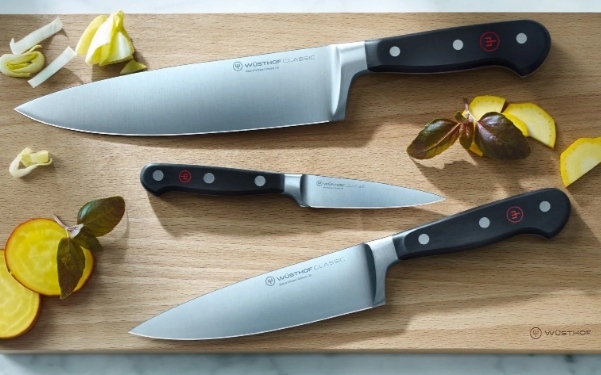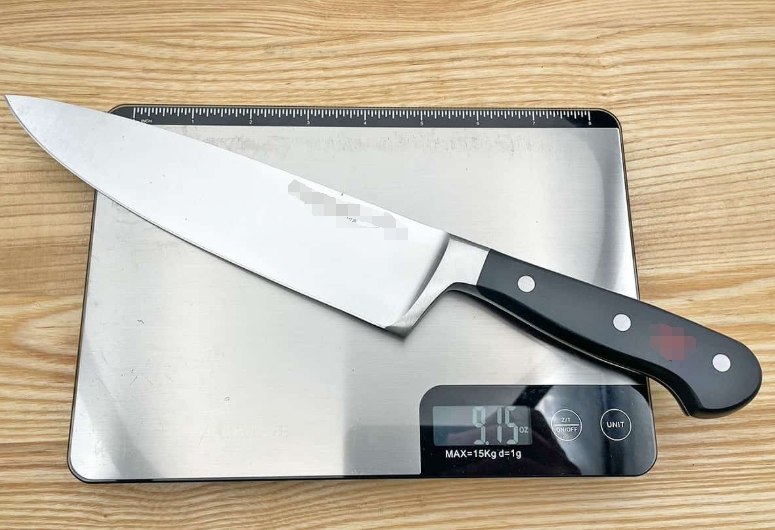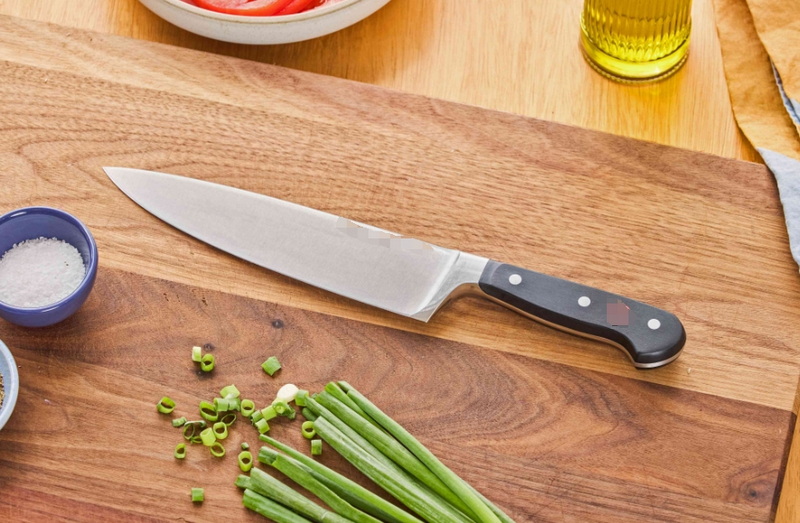

Views: 222 Author: Ella Publish Time: 2025-04-19 Origin: Site








Content Menu
● Understanding Meat Knives: Types and Uses
● Top 7 Kitchen Knives for Cutting Meat at Home
>> Comparing Western vs. Japanese Meat Knives
● How to Choose the Best Meat Knife for Your Kitchen
● Expert Tips for Cutting Meat at Home
● Common Mistakes to Avoid When Cutting Meat
● How to Build Your Own Meat Knife Set
● FAQ: Best Kitchen Knife for Meat Cutting at Home
>> 1. What is the best all-purpose knife for cutting meat at home?
>> 2. What's the difference between a boning knife and a butcher knife?
>> 3. Why do some meat knives have Granton (scalloped) edges?
>> 4. How do I safely cut through bones at home?
>> 5. How should I maintain and store my meat knives?
When it comes to preparing meat at home, the right kitchen knife can make all the difference—whether you're breaking down a whole chicken, slicing a roast, or trimming steaks. But with so many knife types and brands on the market, how do you choose the best kitchen knife for meat cutting at home? This comprehensive guide will walk you through the essential knife types, top recommendations, practical tips, and frequently asked questions to help you become a more confident home butcher.

Choosing the best knife for meat cutting starts with understanding the different types of knives designed for various meat prep tasks. Here's a breakdown of the most common meat knives and their primary uses:
| Knife Type | Description & Best Use |
|---|---|
| Chef's Knife | Versatile, all-purpose knife for slicing, dicing, and chopping meat and vegetables. Usually 6–10 inches long. Ideal for general meat prep and portioning. |
| Boning Knife | Thin, flexible blade (5–7 inches) for removing bones, trimming fat, and filleting meat or fish. Essential for precision work. |
| Butcher Knife | Large, curved blade for breaking down big cuts, portioning, and trimming. Heavier and longer than chef's knives. |
| Cimeter/Scimitar | Long, curved blade (10–14 inches) for slicing large cuts into steaks or roasts. Great for smooth, single-stroke slicing. |
| Carving/Slicing Knife | Long, thin blade (8–14 inches) for slicing cooked meats, roasts, and brisket. Often features a Granton edge to prevent sticking. |
| Cleaver | Heavy, rectangular blade for chopping through bones and tough cuts. Also useful for mincing and crushing. |
The effectiveness of a kitchen knife for meat cutting comes down to its design. The blade's thickness, flexibility, and edge geometry all play crucial roles. For example, a boning knife's narrow, flexible blade allows you to maneuver around bones and joints, minimizing waste. In contrast, a cleaver's thick, heavy blade provides the momentum needed to power through bone and cartilage.
The handle is equally important. A well-designed, ergonomic handle ensures a secure grip, reducing fatigue and the risk of accidents during extended prep sessions. Materials like pakkawood, G10 composite, or textured polymers are popular choices for their durability and comfort.
Based on chef recommendations, expert reviews, and real-world testing, here are the top knives for meat cutting at home:
| Knife Model | Type | Best For | Key Features |
|---|---|---|---|
| Victorinox Fibrox 6-Inch Boning Knife | Boning Knife | Trimming, deboning, filleting | Flexible, razor-sharp, non-slip handle, affordable. |
| Mercer Culinary 12-Inch Granton Edge Cimeter | Cimeter | Slicing large cuts, steaks | Long, sharp blade, Granton edge, budget-friendly. |
| Wüsthof Classic 9-Inch Carving Knife | Carving Knife | Carving roasts, poultry | Pointed tip, super-sharp, well-balanced. |
| Victorinox 7-Inch Restaurant Cleaver | Cleaver | Chopping through bones, big cuts | Heavy-duty, sharp, nimble, walnut handle. |
| Dalstrong Gladiator 10-Inch Butcher Knife | Butcher Knife | Breaking down primal cuts | High-carbon steel, ergonomic handle, durable. |
| Imarku Japanese 8-Inch Chef Knife | Chef's Knife | General meat prep, slicing | Multi-purpose, sharp, comfortable grip. |
| Zelite Infinity 8-Inch Damascus Chef Knife | Chef's Knife | Precision slicing, all-purpose | Damascus steel, long-lasting sharpness. |
Western meat knives, such as those from Wüsthof or Victorinox, typically feature heavier, thicker blades and a double-beveled edge. They are built for durability and power, making them ideal for tough cuts and bones.
Japanese knives, like the Imarku or Zelite Infinity, are often lighter, sharper, and have a thinner, harder blade. They excel at precision slicing and delicate work, such as preparing sashimi or trimming fat.
Both styles have their place in the home kitchen. Many chefs recommend owning at least one of each to handle a wide range of meat prep tasks.
Consider these factors when selecting a meat knife:
Task Specificity:
- For deboning and trimming, a boning knife is essential.
- For slicing large roasts or brisket, opt for a cimeter or slicing knife.
- For breaking down whole chickens or ribs, a cleaver or butcher knife is best.
Blade Material:
- High-carbon stainless steel offers a balance of sharpness, durability, and rust resistance.
- Damascus steel knives are prized for edge retention and aesthetics but require more care.
Blade Length and Shape:
- Longer blades (10–14 inches) are ideal for smooth slicing of large cuts.
- Shorter, flexible blades (5–7 inches) are better for precision tasks like boning and filleting.
- Handle Comfort and Safety:
- Non-slip, ergonomic handles reduce fatigue and improve control, especially when working with slippery proteins.
Maintenance:
- Choose a knife that is easy to sharpen and maintain. Hand-wash and dry immediately to prevent rust.
While premium knives can cost hundreds of dollars, there are many excellent, budget-friendly options for home cooks. The Victorinox Fibrox line, for example, is beloved by professionals and amateurs alike for its sharpness, comfort, and value. Investing in a high-quality knife pays off in the long run, as it will hold its edge longer and perform better with proper care.

Proper care extends the life and performance of your meat knives:
- Hand-wash only: Avoid dishwashers, which can dull and damage blades.
- Dry immediately: Prevent rust and corrosion, especially with carbon steel knives.
- Store safely: Use a knife block, magnetic strip, or blade guard.
- Sharpen regularly: Use a honing rod for maintenance and a whetstone for sharpening.
- Cut on appropriate surfaces: Use wood or plastic cutting boards to preserve the edge.
A sharp knife is a safe knife. Regular honing keeps the edge aligned, while periodic sharpening restores the blade's cutting power. For best results, use a whetstone or a professional sharpening service. Electric sharpeners are convenient but may remove more metal than necessary, shortening your knife's lifespan.
Grip the Knife Properly:
- Hold the handle firmly, with your thumb and forefinger gripping the blade for control.
Use the Right Motion:
- Slice with a smooth, single stroke for clean cuts. Avoid sawing back and forth, which can tear the meat.
Let the Knife Do the Work:
A sharp, well-balanced knife should glide through meat with minimal force.
Match Knife to Meat Type:
- Use a boning knife for poultry and fish.
- Use a cimeter or carving knife for roasts and brisket.
- Use a cleaver for bones and tough cuts.
Safety First:
- Keep your knives sharp—dull knives are more dangerous due to the extra force required.
Even with the best knife, technique matters. Here are some pitfalls to watch out for:
Using the Wrong Knife:
- Don't try to debone a chicken with a chef's knife or slice brisket with a cleaver. Each knife is designed for a specific purpose.
Cutting on Hard Surfaces:
- Avoid glass, stone, or metal cutting boards, as they can quickly dull your blade. Stick to wood or high-quality plastic.
Applying Excessive Force:
- If you need to push hard, your knife is either dull or you're using the wrong tool. Let the sharp edge do the work.
Neglecting Knife Maintenance:
- A dull or dirty knife is unsafe and ineffective. Clean and sharpen your knives regularly.
Improper Storage:
- Tossing knives in a drawer can damage the blade and cause accidents. Always use a block, magnetic strip, or blade guard.
If you're serious about meat preparation at home, consider building a dedicated meat knife set. Here's a suggested lineup:
1. Chef's Knife (8–10 inches): For general prep, slicing, and portioning.
2. Boning Knife (6 inches): For deboning, trimming, and filleting.
3. Butcher Knife or Cimeter (10–12 inches): For breaking down large cuts and slicing steaks.
4. Carving/Slicing Knife (8–14 inches): For roasts, brisket, and cooked meats.
5. Cleaver: For bones, ribs, and tough cuts.
Invest in quality over quantity. A few well-chosen knives will serve you better than a large set of mediocre blades.
The best kitchen knife for meat cutting at home depends on your specific needs, cooking style, and budget. For most home cooks, a combination of a quality chef's knife and a dedicated boning knife will cover the majority of meat prep tasks. If you frequently work with large cuts, adding a cimeter or slicing knife, and a sturdy cleaver, will make your kitchen arsenal complete.
Top Recommendations:
- For versatility and value: Victorinox Fibrox 6-Inch Boning Knife and Imarku Japanese 8-Inch Chef Knife
- For large cuts and precision: Mercer Culinary 12-Inch Cimeter and Wüsthof Classic 9-Inch Carving Knife
- For heavy-duty tasks: Victorinox 7-Inch Restaurant Cleaver
Investing in a high-quality meat knife (or set) will not only improve your efficiency and safety in the kitchen but also elevate the quality of your meals. Remember, the best knife is the one that feels comfortable, stays sharp, and suits your cooking needs.

A chef's knife (8–10 inches) is the most versatile option for general meat prep, slicing, and portioning. For specialized tasks like deboning or breaking down large cuts, consider adding a boning knife or cimeter to your collection.
A boning knife has a thin, flexible blade designed for removing bones and trimming fat with precision. A butcher knife is larger, heavier, and used for breaking down big cuts and portioning meat.
Granton edges (the dimples along the blade) help prevent meat from sticking to the knife, allowing for smoother, cleaner slices—especially useful when slicing roasts or brisket.
Use a meat cleaver or heavy-duty butcher knife with a straight, thick blade. Ensure your cutting board is stable and use controlled, deliberate force to avoid accidents.
Hand-wash and dry immediately after use, store in a knife block or on a magnetic strip, and regularly hone and sharpen the blade. Avoid using the knife on hard surfaces or in the dishwasher to maintain its edge.
[1] https://www.foodandwine.com/lifestyle/best-butcher-knives-according-chefs
[2] https://www.dexterrussellcutlery.com/types-of-knives-and-their-uses/
[3] https://sharpedgeshop.com/blogs/knives-101/how-to-choose-a-kitchen-knife
[4] https://www.youtube.com/watch?v=S4XICQdlEWc
[5] https://yakushiknives.com/blogs/yakushi-blog-all-thing-knives/why-every-home-chef-needs-a-quality-butcher-knife-set
[6] https://imarku.net/blogs/news/ultimate-guide-to-owning-a-meat-knife-in-2022
[7] https://www.reddit.com/r/chefknives/comments/141n5kh/meat_butchery_what_kind_of_knife_do_you_use/
[8] https://www.seriouseats.com/the-best-carving-and-slicing-knives-equipment
[9] https://www.seriouseats.com/the-best-essential-knives
[10] https://dalstrong.com/blogs/news/meat-knife
[11] https://www.seriouseats.com/how-to-choose-buy-care-for-a-meat-cleaver
[12] https://www.youtube.com/watch?v=_JdOQhNTjMg
[13] https://www.nytimes.com/wirecutter/reviews/the-best-chefs-knife-for-most-cooks/
[14] https://www.goodhousekeeping.com/cooking-tools/best-kitchen-knives/g28555679/best-butcher-knives/
[15] https://kyokuknives.com/collections/knives-for-cutting-meat
[16] https://www.youtube.com/watch?v=b333hq9gk8c
[17] https://www.foodnetwork.com/how-to/packages/shopping/product-reviews/best-chefs-knife
[18] https://www.reddit.com/r/Cooking/comments/x7jkqe/whats_a_good_knife_for_cutting_meat_thats_under/
[19] https://seidoknives.com/collections/butcher-knives
[20] https://madeincookware.com/blogs/types-of-kitchen-knives
[21] https://www.youtube.com/watch?v=GjHaMLsHUUQ
[22] https://smokingmeatgeeks.com/best-knives-under-50/
[23] https://www.youtube.com/watch?v=b333hq9gk8c
[24] https://cutco.com/shop/kitchen-knives
[25] https://www.webstaurantstore.com/guide/538/types-of-knives.html
[26] https://www.kitchenknifeforums.com/threads/basic-meat-cutting-knife-suggestion.36357/
[27] https://www.meatyourmaker.com/new/meat-kitchen-knife-set/1135983.html
[28] https://www.youtube.com/watch?v=B3eUbUHTklg
[29] https://www.goodhousekeeping.com/cooking-tools/best-kitchen-knives/g28555679/best-butcher-knives/
[30] https://www.shutterstock.com/search/butcher-knife
[31] https://nymag.com/strategist/article/best-kitchen-knife-sets.html
[32] https://www.wusthof.com/collections/all-purpose-knives/chefs-knives
[33] https://www.youtube.com/watch?v=QgVyN6Lpiuc
[34] https://stock.adobe.com/search?k=butcher+knife
[35] https://www.reddit.com/r/chefknives/comments/141n5kh/meat_butchery_what_kind_of_knife_do_you_use/
[36] https://www.youtube.com/watch?v=TnPAKEU3kmY
[37] https://www.youtube.com/watch?v=o_QWK4AC7R0
[38] https://www.youtube.com/watch?v=aOo7w9IfWy0
[39] https://www.youtube.com/watch?v=jLqedS1MQmY
[40] https://www.youtube.com/watch?v=-al-bs737fw
[41] https://www.youtube.com/watch?v=st6LggwoL_4
[42] https://www.youtube.com/watch?v=8wgc7rv5WJc
[43] https://www.reddit.com/r/Butchery/comments/1h0d8o8/knife_for_cutting_meat/
[44] https://www.reddit.com/r/chefknives/comments/ppuhnv/what_do_you_use_each_of_these_for_and_do_i_need/
[45] https://www.forksoverknives.com/how-tos/knife-skills-cutting-technique/
[46] https://www.reddit.com/r/chefknives/comments/1bg1pg2/what_are_the_best_chef_tools_to_cut_up_whole_meat/
[47] https://www.bladeforums.com/threads/which-knife-is-best-for-cutting-meat.1792947/
[48] https://www.thebambooguy.com/blogs/kitchen-knives/frequently-asked-questions-about-kitchen-knives
[49] https://sharpedgeshop.com/blogs/knives-101/guide-maintenance-of-kitchen-knives
[50] https://www.chefknivestogoforums.com/viewtopic.php?t=14477
[51] https://elementknife.com/pages/common-questions-about-kitchen-knives
[52] https://simplylocalbillings.com/making-the-cut-a-guide-to-kitchen-knives
[53] https://www.lifesmile.ae/blog/posts/what-is-the-best-knife-for-cutting-vegetables-and-meat
[54] https://www.reddit.com/r/wholefoods/comments/1jld0zt/meat_cutting_question_about_knives/